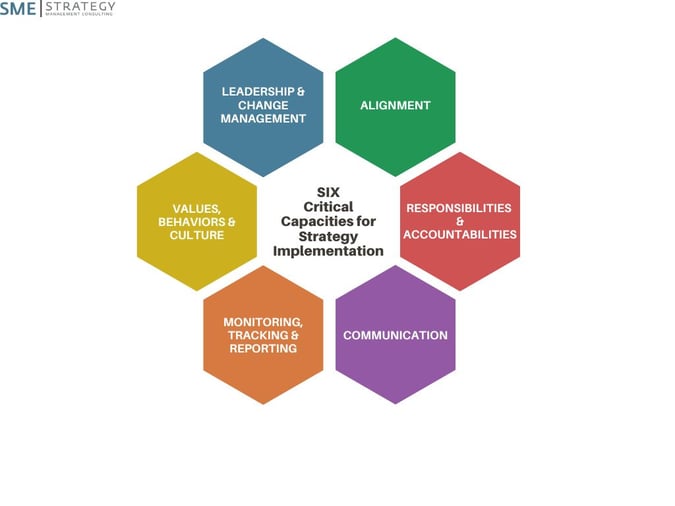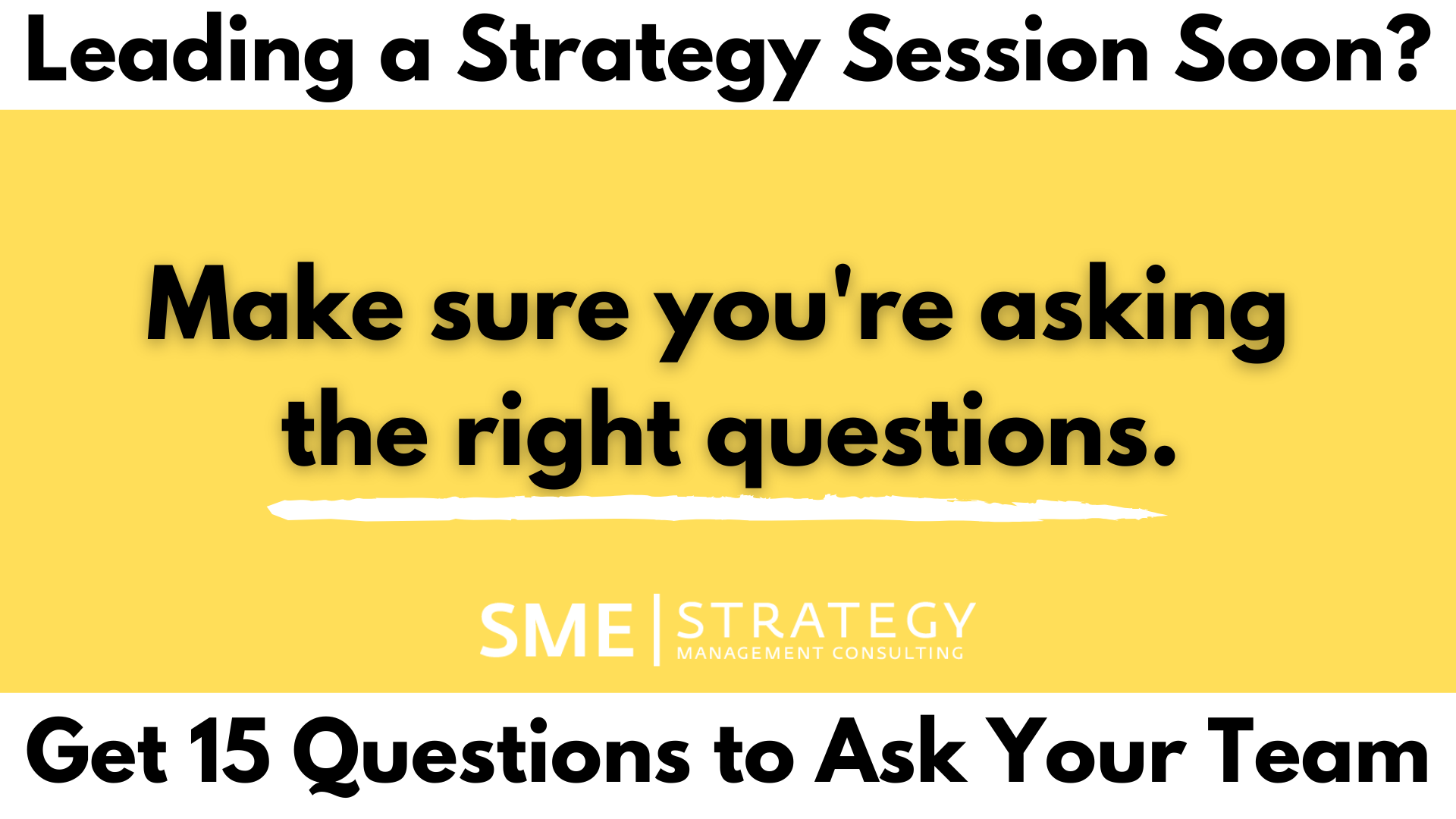Strategic plan Implementation: How to connect your strategy to your operations

Words: 1063. Reading time: 5 mins.
SME Strategy is a strategy consulting firm that specializes in helping organizations align their teams and operations around a shared vision, mission, values, goals, and action plans. Our strategic planning services offer guidance on how a strategic planning facilitator can provide support in creating a strategic plan is communicated and implemented across your entire organization.
One of the most common questions we get asked after working with organizations to develop their strategic plan is: “How can we connect our strategy to our business operations?”
Before connecting organizational strategy to business operations, it is critical that senior organizational leaders have a plan in place for how they will tackle their strategic plan implementation and how they will build the capacities within their key leaders, middle managers, and people to continue sustained strategic thinking and execution throughout the plan duration.
Whether organizations work with our team to guide them through their strategic plan implementation or they lead the strategy implementation cycle themselves, it’s critical that there is a clear schedule in place to ensure that momentum is not lost, and your strategy ultimately executed.
Once an organization has begun the strategy implementation process, it’s important to review the strategic plan to ensure that the key leaders and teams are aligned around the organization’s vision, mission, values, and strategic priorities. If not completed within the strategic planning process, it’s important that measurable goals with KPIs as well as action plans are developed to ensure that specific outcomes can be monitored and tracked on an ongoing basis.
We can help you align your team around a clear vision, mission, values, goals and action plans,
so you can lead your organization more effectively and get better results.
Balancing Strategy & Operations
Once this is all in place, senior leaders can begin to think about how much of their time should be spent on the strategic implementation process (working ON the business) and how much time should be spent on the day-to-day operations (working IN the business). While there’s no perfect ratio, many organizations benefit from an average split of 20% strategic time and 80% operational time, which often leads to a strong balance of critical work taking place, with enough time allotted to reaching key organizational goals and milestones.
Individual ratios may differ. For example, a CEO may spend 50% of their time on strategic work, while a production worker may spend 5%.
This ongoing balance is important, as strategy and strategic thinking considers the mid to long-term (making calculated decisions that balance future direction, risk and competitive advantages) while operations considers the short-term (doing the essential day-to-day work to ensure the organization keeps moving). Strategy is what can help refine your future products, services, systems, and processes to enhance operations in the long run.
While that’s one potential ratio, it’s important to recognize that strategy and operations aren’t always divided. When implementation is done well, many elements of your current strategy are either achieved or eventually integrated into your business operations.
How is Strategy Integrated into Business Operations?
We focus on building 6 Critical Capacities within leadership teams not only to help them with their implementation and strategic goal accomplishment but also to help them deepen the connection between what they’re reaching for strategically and what they’re doing operationally.
We look at it as implementing the plan and developing the right environment around the plan to support a successful strategy implementation process.
Here are the 6 critical elements for successful strategy implementation.

- Alignment
- Alignment between the organization’s vision, mission, values & priorities, is the first step to ensure that this cascades down into projects, initiatives, and action
- Alignment between individuals & departments will help to ensure that everyone is working toward the same strategic outcomes. This often leads to greater proactivity and less operational “firefighting” when things go wrong
- Alignment will also help the people within an organization understand the strategic direction which can help them make decisions within their day-to-day in that are in line with the organizational directions.
- By helping your people understand the connection with what THEY DO in their operational day-to-day work, they will better understand how they can help the organization reach its vision and mission.
- Responsibilities and Accountabilities
- Clear roles, responsibilities, and deadlines for specific components of your strategic plan implementation process will help to ensure that important work moves forward.
- Clear roles & responsibilities for projects and initiatives that align with either the three organizational strategic priorities or core operational work is also critical to ensure specific people will take charge of moving these pieces of work forward, whether strategically or operationally
- When people understand who is responsible for what by when, added accountability is in place, duplicate work is reduced, and decisions can be made more effectively.
- Communication
- Structures and processes for fostering STRATEGIC level communication are critical to keeping the core senior leaders aligned around the strategic direction on a regular basis
- These may include: monthly strategy check-ins, quarterly strategy reviews, annual strategy development
- Structures and processes for regular communication around projects and initiatives related to the three strategic priorities and core operations are critical to keeping teams and individuals on track for key deliverables
- These may include: team charters, project charters, project status meetings, slack channels, project management software
- Structures and processes for regular communication for the day-to-day operational work are critical to keeping information flowing between departments, teams, and individuals to reduce silos and duplication of work
- These may include: daily or weekly “stand-up” meetings, monthly all-hands meetings, town halls, or other communication initiatives
- By communicating up, down, and across your organization, and implementing the necessary processes and structures to enable this, organizational-wide alignment and buy-in will be stronger, people will know who to connect with for what information or key decisions, and they will be equipped to make the essential decisions within their role and capabilities
- Monitoring, Tracking, and Reporting
- If an aligned data management strategy for tracking & monitoring is integrated, everyone will know who is responsible for what, by when if they have a shared dashboard for key information and updates on strategic initiatives and projects
- Determining a monitoring and reporting cadence (ex: monthly or quarterly) will help to reinforce accountability as team members will be responsible for gathering qualitative and quantitative data on strategic initiatives and key projects within a set time frame
- When done regularly, monitoring, tracking, and reporting helps senior leaders to understand whether strategic priorities, strategic goals, and projects are on track, behind, or ahead. This contributes to proactivity around resource allocation and allows pivots and decisions to be made before it’s too late at both strategic and operational levels of the organization
- Note: If you want until the end of each year to monitor, track and report on your initiatives, you will find out after the fact if you’ve missed targets. This will leave you without the chance to double down your efforts or change your course of action, or allocate resources elsewhere if you’ve exceeded targets, rather than continuing to pour valuable resources into completed initiatives
- Values, Behaviors, and Culture
- Because culture is an outcome of an organic process and is something that cannot be created or enforced, leaders must pay close attention to fostering the types of values and behaviors that they believe will lead to the type of culture that aligns with the future they would like to achieve.
- After developing a strategic plan that includes alignment between the organization’s vision and mission as well as the values, it’s critical for leaders to share these values and associated behaviors with their people. This will help to foster a culture that aligns with the organization’s strategic direction.
- Leaders must communicate (2-way communication is recommended to increase buy-in), demonstrate, and reinforce these values to help them become consistent throughout the organization.
- If leaders act counter to these values and behaviors, others will follow in the wrong direction, and if leaders reward undesirable behaviors, then these too will spread.
- Leadership and Change Management
- Strategic plan implementation often requires various levels of change that could include minor shifts like software implementation to major changes like mergers and acquisitions. These may often begin at the strategic level and become operationalized over time
- It’s critical to understand that people are at the heart of change, and they may have their own perspectives and feelings surrounding change. By assessing change readiness and conducting stakeholder engagement (internal & external) before diving into a major change initiative, buy-in will be more likely.
- When done well, leaders undertaking change management consider both the people involved and processes (such as the Kotter Model or Prosci ADKAR) needed to effectively prepare, initiate and sustain change
If you focus on these six critical capacities for strategy implementation, your organization will be more likely to achieve your goals, have strong alignment up, down, and across your organization, and thus connecting multiple elements of your strategic plan to your core business operations.
One way to gain the most impact while implementing your strategic plan and building your organizational capacity is to work with specialized strategic planning consultants and coaches to help guide you through the process, offering an extra layer of accountability and subject matter expertise in strategy, leadership, and implementation every step of the way. Alternatively, a senior leader may decide to lead the implementation and support capacity building with their team.
The question we’d encourage you to ask yourself is: “How much is the success of this plan worth to us? And what is the cost of us not accomplishing the plan?”
For many of our clients, whose projects and visions have aims in the tens of millions of dollars and whose organizations employ hundreds of staff, the cost of not implementing the plan successfully is quite high.
Having the right implementation plan, the right resource allocation and the right alignment between strategy and operations are a couple of ways to increase the likelihood of realizing that economic benefit and realizing your strategic vision. 



